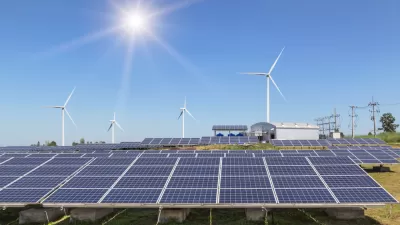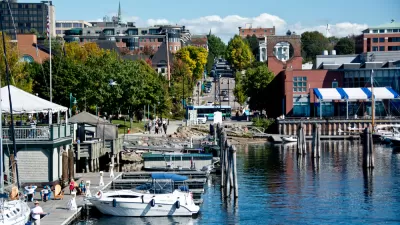Talk about bringing power to the people: eight regional governments in California are in various stages of adopting "community choice" utilities to buy power from the grid in the hopes of cleaning up their energy portfolio.
"From Silicon Valley to the East Bay to the Central Coast, a "people's power" movement is sweeping through California that will give local residents a choice to ditch PG&E and buy cleaner -- and possibly cheaper -- energy from the cities and counties where they live," reports Tracy Seipel.
Specifically, Seipel is referring to "community choice" utilities, currently place in three counties around the state but under consideration for many more. Seipel explains more about how the community choice utilities operate:
"Overseen by a team of energy experts and a board of elected officials, new community-run utilities are buying power from the grid, procuring a higher percentage of renewable energy -- think solar and wind, as well as methane from dairy cows -- than PG&E, while aiming for a price around or even below the giant utility's rates. The new power systems also are charged with developing more local renewable energy."
Seipel also sums up the political debate surrounding the idea, noting that critics of the arrangement call community choice "a feel-good solution that will lead to unstable prices, empty promises and -- at least for the time being -- no additional green energy."
The remainder of the article focuses on the fortunes of the community choice utilities so far, as well as insight into the slightly esoteric but still critical matter of the "exit fee" that determines how expensive the model is in any given month.
FULL STORY: Bay Area communities gearing up to create their own power systems

Maui's Vacation Rental Debate Turns Ugly
Verbal attacks, misinformation campaigns and fistfights plague a high-stakes debate to convert thousands of vacation rentals into long-term housing.

Planetizen Federal Action Tracker
A weekly monitor of how Trump’s orders and actions are impacting planners and planning in America.

San Francisco Suspends Traffic Calming Amidst Record Deaths
Citing “a challenging fiscal landscape,” the city will cease the program on the heels of 42 traffic deaths, including 24 pedestrians.

Opinion: What San Francisco’s Proposed ‘Family Zoning’ Could Really Mean
Mayor Lurie is using ‘family zoning’ to encourage denser development and upzoning — but could the concept actually foster community and more human-scale public spaces?

Jacksonville Launches First Autonomous Transit Shuttle in US
A fleet of 14 fully autonomous vehicles will serve a 3.5-mile downtown Jacksonville route with 12 stops.

‘Big, Beautiful Bill’ Guts EV Tax Credits
The bill eliminates federal subsidies for electric vehicle buyers and charging stations.
Urban Design for Planners 1: Software Tools
This six-course series explores essential urban design concepts using open source software and equips planners with the tools they need to participate fully in the urban design process.
Planning for Universal Design
Learn the tools for implementing Universal Design in planning regulations.
Gallatin County Department of Planning & Community Development
Heyer Gruel & Associates PA
JM Goldson LLC
City of Camden Redevelopment Agency
City of Astoria
Transportation Research & Education Center (TREC) at Portland State University
Jefferson Parish Government
Camden Redevelopment Agency
City of Claremont





























